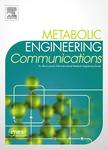版权所有:内蒙古大学图书馆 技术提供:维普资讯• 智图
内蒙古自治区呼和浩特市赛罕区大学西街235号 邮编: 010021

作者机构:National Key Laboratory of Biochemical Engineering Institute of Process Engineering Chinese Academy of Sciences Beijing 100190 China University of Chinese Academy of Sciences Beijing 100049 China Department of Chemical and Biomolecular Engineering North Carolina State University Raleigh 27695-7905 NC United States
出 版 物:《Metabolic Engineering Communications》 (Metab. Eng. Commun.)
年 卷 期:2018年第7卷
页 面:e00074-e00074页
学科分类:0831[工学-生物医学工程(可授工学、理学、医学学位)] 0710[理学-生物学] 1002[医学-临床医学] 1001[医学-基础医学(可授医学、理学学位)] 07[理学] 071009[理学-细胞生物学] 09[农学] 0901[农学-作物学] 0836[工学-生物工程] 090102[农学-作物遗传育种]
基 金:National High Technology Research and Development Programme of China, (2014AA021905) Chinese Academy of Sciences, CAS, (ZSYS-015) Chinese Academy of Sciences, CAS
主 题:(R)-acetoin Cofactor regeneration D-xylose Ethylene glycol In vitro metabolic engineering
摘 要:(R)-acetoin is a four-carbon platform compound used as the precursor for synthesizing novel optically active materials. Ethylene glycol (EG) is a large-volume two-carbon commodity chemical used as the anti-freezing agent and building-block molecule for various polymers. Currently established microbial fermentation processes for converting monosaccharides to either (R)-acetoin or EG are plagued by the formation of undesirable by-products. We show here that a cell-free bioreaction scheme can generate enantiomerically pure acetoin and EG as co-products from biomass-derived D-xylose. The seven-step, ATP-free system included in situ cofactor regeneration and recruited enzymes from Escherichia coli W3110, Bacillus subtilis shaijiu 32 and Caulobacter crescentus CB 2. Optimized in vitro biocatalytic conditions generated 3.2 mM (R)-acetoin with stereoisomeric purity of 99.5% from 10 mM D-xylose at 30 °C and pH 7.5 after 24 h, with an initial (R)-acetoin productivity of 1.0 mM/h. Concomitantly, EG was produced at 5.5 mM, with an initial productivity of 1.7 mM/h. This in vitro biocatalytic platform illustrates the potential for production of multiple value-added biomolecules from biomass-based sugars with no ATP requirement. © 2018 The Authors